Chilliwack | |
|---|---|
| City of Chilliwack | |
 Flag 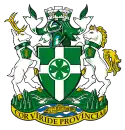 Seal Logo | |
| Nickname: The Wack | |
| Motto(s): "Cor Viride Provinciae" (Latin) "The Green Heart of the Province" | |
 Location of Chilliwack in British Columbia 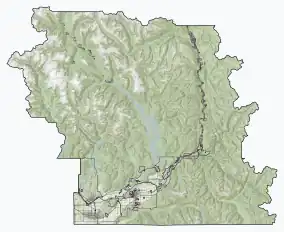 Chilliwack (Fraser Valley Regional District) | |
| Coordinates: 49°09′27.8″N 121°57′03.3″W / 49.157722°N 121.950917°W | |
| Country | Canada |
| Province | British Columbia |
| Regional district | Fraser Valley |
| Founded | 1873 |
| Incorporated | 1908 |
| Government | |
| • Mayor | Ken Popove |
| • Governing body | Chilliwack City Council |
| Area | |
| • City | 261.34 km2 (100.90 sq mi) |
| Elevation | 10 m (30 ft) |
| Population (2021) | |
| • Density | 356.6/km2 (924/sq mi) |
| • Metro | 113,767 |
| • Metro density | 78.8/km2 (204/sq mi) |
| Time zone | UTC−08:00 (PST) |
| • Summer (DST) | UTC−07:00 (PDT) |
| Forward sortation area | |
| Area code(s) | 604, 778, 236, 672 |
| Highways | |
| Waterways | Chilliwack River, Vedder River, Fraser River, Hope River |
| Website | www |
Chilliwack (/ˈtʃɪləwæk/ CHIL-ə-wak) is a city in the province of British Columbia, Canada. Chilliwack is surrounded by mountains and home to recreational areas such as Cultus Lake and Chilliwack Lake Provincial Parks. There are numerous outdoor activities in the area in which to participate, including hiking, rock climbing,[1] mountain biking[2] horseback riding, whitewater kayaking,[3] camping, fishing, golf, and paragliding.[4] Chilliwack is known for its annual corn harvest, and is home to the Province's second largest independent bookstore The Book Man. The Fraser Valley Regional District is headquartered in Chilliwack, which is the Fraser Valley's second-largest city, after Abbotsford.
The city had a population of 93,203 in the 2021 Canadian census, with a census metropolitan area population of 113,767 people.[5]
Etymology
In Halq'eméylem, the language of the Stó:lō communities around Chilliwack and Sardis, Tcil'Qe'uk means "valley of many streams".[6] It also lends its name to the Chilliwack River, and group of aboriginal people, the Ts'elxwéyeqw (also spelt Ts'elxwíqw or Sts'elxwíqw).[7] The spelling of Chilliwack is sometimes a matter of confusion. Prior to the amalgamation of the City of Chilliwack and the Municipality of Chilliwhack, there were two different spellings. When amalgamated, the current spelling of the city was adopted.[8] Anglicized spellings include "Chilliwhyeuk" and other versions closer to the original Halq'eméylem.
History
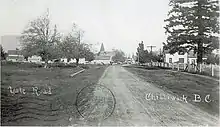
The archeological record shows evidence of Stó:lō people in the Fraser Valley, or S'ólh Téméxw, 10,000 years ago. Permanent structures in the Chilliwack area date from around 5,000 years ago.[9] It is estimated that at the time of the first contact with Europeans, there were as many as 40,000 people living within Stó:lō territory.
By 1859, over 40,000 gold miners had trekked to the goldfields of the upper Fraser River, many travelling through the Chilliwack area. By the mid-1860s, several farms had grown up around the steamboat landings on the Fraser River called Miller's Landing, Minto Landing, Sumas Landing and Chilliwack Landing.
The Township of Chilliwhack was incorporated in 1873, the third municipality in British Columbia. The initial settlement was along the Fraser River at Chilliwack Landing. Steamboats were the main mode of transportation, carrying goods and passengers between Chilliwack and New Westminster. After the construction of the Canadian Pacific Railway in 1885, many residents began to cross the Fraser River at Minto Landing to catch the train at Harrison Mills.
With little room for expansion along the river, the commercial area of the town moved south to the junction of the New Westminster-Yale Wagon Road, Wellington Avenue and Young Road, called "Five Corners". A large subdivision called Centreville was built in 1881. The name "Centreville" was replaced In 1887 by the more popular "Chilliwack."
The Chilliwack area experienced extensive flooding in the 1894 Fraser River flood.
The Chilliwack (formerly Centreville) area was incorporated in 1908 as a separate municipality, the City of Chilliwack. The city and the township co-existed for 72 years.
The Chilliwack area again experienced extensive flooding in the 1948 Fraser River flood.
In 1980, the Township of Chilliwhack and the City of Chilliwack merged to form the District of Chilliwack. The District of Chilliwack became the City of Chilliwack in early 1999.
In November 2021, an atmospheric river caused widespread flooding in Chilliwack, forcing major roads, including Highway 1, to close indefinitely.[10] The Highway has since been reopened for traffic in this area.
Geography


Chilliwack is located in the Upper Fraser Valley, 100 kilometres (60 mi) east of Vancouver on the Trans-Canada Highway. The city is bounded on the north by the Fraser River, and on the south by the Canada-United States border.
Chilliwack is surrounded by tall mountain peaks, such as Mount Cheam and Slesse Mountain, and large rivers (the Fraser and Vedder).
Geology
The Chilliwack Batholith forms much of the North Cascades in southwestern British Columbia, Canada and the U.S. state of Washington. The geological structure is primarily named after the City of Chilliwack, where it is the most notable geological feature.
The Chilliwack Batholith is part of the Pemberton Volcanic Belt and is the largest mass of exposed intrusive rock in the Cascade Volcanic Arc. The age of the Chilliwack batholith ranges from 26 to 29 million years old.
In 2013, Maclean's reported that, with an average annual temperature of 10.5 °C (50.9 °F), Chilliwack is the warmest city in Canada.[11]
Cityscape
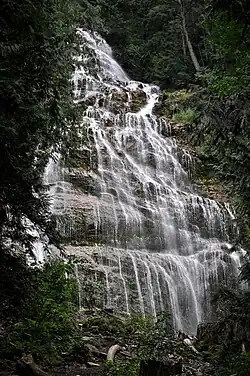
The city is made up of several amalgamated villages and communities. The urban core follows a north–south axis bisected by the Trans-Canada Highway. The city is bounded in the north by the Fraser River, in the east by the Eastern Hillsides, in the south by the Canada–US border, and in the west by the Vedder Canal. With 939 farms on approximately 17,322 hectares (42,800 acres) of dedicated farmland, farming remains an important part of the Chilliwack landscape.[12]
Neighbourhoods
Neighbourhoods on the north side
Also referred to as "Chilliwack Proper Village West", the north side covers the area from the Trans-Canada Highway in the south, to the Fraser River in the north, and includes the communities of Camp River, Chilliwack Mountain, Downtown Chilliwack, East Chilliwack, Fairfield Island, Rosedale and Popkum. Downtown Chilliwack is the historical urban centre of the city. Several cultural attractions, such as the Chilliwack Coliseum, Chilliwack Cultural Centre, The Book Man and the Eagle Landing Shopping Centre are located there, as well as key government buildings, such as city hall, FVRD offices, and the Provincial Court of British Columbia.
Neighbourhoods on the south side
The south side includes the communities of Atchelitz, Cultus Lake Park, Greendale, Promontory Heights, Ryder Lake, Sardis, Vedder Crossing, Garrison Crossing and Yarrow. Sardis is the urban core of the south side and is a popular shopping destination.
Parks
- Bridal Veil Falls Provincial Park
- Cheam Wetlands Regional Park
- Chilliwack Heritage Park
- Chilliwack Lake Provincial Park
- Cultus Lake Provincial Park
- Fairfield Park
- Great Blue Heron Nature Reserve
- Gwynne Vaughn Park
- Island 22
- Salish Park
- Sardis Park
- Townsend Park
Arts and culture

Music
Chilliwack has an active rock music scene, centering mostly around young ska and punk rock bands. Bands originating in Chilliwack include: These Kids Wear Crowns, Mystery Machine, and The Darkest of the Hillside Thickets.
Chilliwack also has a thriving classical music community, featuring the Chilliwack Symphony Orchestra and the Chilliwack Metropolitan Orchestra.
The drumline from Sardis Secondary School played at several venues during the 2010 Winter Olympics in Vancouver.
Chilliwack also offers many other community events and classes throughout the year. The Downtown Chilliwack Business Improvement Association is hosting music in Central Park on Saturdays for the month of August 2022.
Despite their name, the band Chilliwack was actually formed, and is based, in nearby Vancouver.
Performing arts
The Chilliwack Cultural Centre is a performing arts venue located in downtown Chilliwack. The building is home to the Chilliwack Players' Guild (the resident theatre company), as well as the Chilliwack Academy of Music.
The UFV Theatre is a 206-seat thrust stage venue formerly belonging to the University of the Fraser Valley (UFV) Theatre Department. Until 2017, UFV produced three or four mainstage shows each year, as well as the annual Directors' Festival, which featured student directors and performers from UFV, Capilano University, Thompson Rivers University, University of Victoria, UBC and Douglas College.[13] As of 2021, the theatre is part of the Imagine High public high school.[14]
The Chilliwack School of Performing Arts provides pre-professional training in acting, singing and dancing to children ages 3–18 at their downtown location. The mainstage show performs a two-week run every January at the Chilliwack Cultural Centre, and a Spring Festival featuring performances from many age groups in late May. Programs at the Chilliwack Performing Arts can be registered for at.[15] Many different programs are available, including a Junior Musical Theatre and Summer Break Camps.
Public Art

The Chilliwack Mural Festival occurs annually. Co-founded and directed by Amber Price and Lise Oakley, their volunteer team has curated and directed the installation of over three dozen works of large scale original art in Historic Downtown Chilliwack.
Murals by Canadian Artists Emmanuel Jarus,[16] Jason Botkin[17] and Chris Perez[18] can be found along with other public art via the Chilliwack Public Art Trail.
Festivals
Annual events and festivals include:
- Chilliwack Bluegrass Festival (ended in 2013)
- Christmas Craft Market
- Chilliwack Art of Wine Festival
- Fraser Valley Culture and Craft Beer Festival
- Fraser Valley Women's Expo
- Party in the Park (ended 2019)
- Chilliwack Canada Day
- Chilliwack Mural Festival
- Chilliwack Pride Festival
Museums
- Chilliwack Sports Hall of Fame
- Canadian Military Education Centre[19]
- Chilliwack Museum and Archives, located in the 1912 former Chilliwack City Hall on Spadina Avenue, is a National Historic Site of Canada.[20] The Chilliwack Museum and Archives are a non-profit organization operated by the Chilliwack Museum and Historical Society which began in 1958 by brothers Oliver and Casey Wells.[21]
Notable people

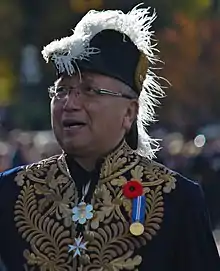
- Academics
- Carin Bondar Ph.D., biologist, writer, filmmaker, speaker and television personality
- Allan Brooks DSO, Ornithologist and distinguished wildlife artist
- Charlotte Froese Fischer, Ph.D., mathematician and computer scientist
- Wayne Smith M.Econ, Chief Statistician of Canada
- Rita Steblin Ph.D., musicologist in Vancouver and Vienna, Austria
- Homer Thompson Ph.D., classical archeologist and excavator of the Ancient Agora of Athens
- Activists
- Tony Clarke, activist, who graduated from Chilliwack Senior Secondary.
- Betty Fox, cancer research activist, mother of Terry Fox.[22]
- Athletes
- Amber Allen, former professional soccer player with the Vancouver Whitecaps.
- Dave Archibald, former professional hockey player with the Minnesota North Stars and Ottawa Senators.
- Jordyn Huitema, soccer player for Seattle Reign FC and the Canada national team
- Rick Klassen, former professional football player with the BC Lions and Saskatchewan Roughriders.
- Marc-Andre Leclerc, solo free climber
- Arts and entertainment
- Patrick Gallagher, actor from Glee, True Blood and Night At The Museum. Graduated from Chilliwack Senior Secondary.
- Bernie Herms, Grammy Award-winning artist[23]
- Inez Jasper, musician
- Bria Skonberg, jazz musician, Juno Award winner for Vocal Jazz Album of the Year in 2017
- Tasha Tilberg, Covergirl model. Born in Chilliwack on July 23, 1979. Appeared on the covers of magazines such as Vogue, Harper's Bazaar and Marie Claire.
- Jim Vallance OC, musician, songwriter, composer, arranger and producer
- Canadian Military
- Mark Isfeld †, combat engineer and UN peacekeeper killed by a landmine
- Piper James C. Richardson †, recipient of the Victoria Cross
- Journalists
- Jack McGaw, journalist and radio operator.
- Diana Swain, television journalist. Graduated from Chilliwack High School in 1983.
- Justices
- William H. Davies KC, Supreme Court Justice and Chair of the Davies Commission Inquiry
- Politicians
- Dorothy Kostrzewa, first Chinese-Canadian woman elected to political office in Canada
- Barry Neufeld, former school trustee
- Barry Penner KC MLA, former Attorney General
- Steven Point OC OBC, first aboriginal Lieutenant-Governor of British Columbia.
- Chuck Strahl MP PC, former cabinet minister
- Writers
- Allan Fotheringham, columnist. Worked for The Chilliwack Progress as a student.
- Gayle Friesen, novelist
- W.P. Kinsella, OC OBC, author of Shoeless Joe, lived in Chilliwack[24]
- Others
- Keith Hunter Jesperson, serial killer who committed crimes in Canada and the U.S
- Prest Family - One of the pioneer Chilliwack families
Media
Newspapers
- Chilliwack Progress - British Columbia's oldest community newspaper, published continuously with the same name in the same community since April 1891
Chilliwack Times published its final edition on December 28, 2016.[25]
Radio
Television
Sports
| Team | League | Sport | Venue | Established |
|---|---|---|---|---|
| Chilliwack Chiefs | BCHL | Ice hockey | Chilliwack Coliseum | 2011 |
| Chilliwack Jets | PJHL | Ice hockey | Sardis Sports Complex | 2020 |
| Valley Huskers | CJFL | Football | Exhibition Stadium | 1999 |
| Chilliwack Crusaders RFC | Third Division | Rugby union | Yarrow Sports Field | 2012 |
The British Columbia Hockey League's Chilliwack Chiefs, play at the Chilliwack Coliseum. The team used to be the Quesnel Millionaires. The franchise was purchased and moved to Chilliwack by the Chiefs Development group. They started in the BCHL's Interior Conference for the 2011/2012 BCHL Season. While the original Junior "A" team, the Chilliwack Chiefs, plays in Langley, British Columbia, as the Langley Rivermen (the Chiefs Development Group sold their interest in the Langley Chiefs but retained the 'Chiefs' name and history). The Western Hockey League's Chilliwack Bruins used to play at the Prospera Centre. The expansion franchise began to play in 2006 and ended when the team was sold at the end of the 2011 season. It became the Victoria Royals WHL hockey team in 2011.
Community sports include hockey, lacrosse, softball, soccer, football, baseball, field hockey and swimming. The Canadian Junior Football League's Chilliwack Huskers play at Exhibition Stadium.
Chilliwack Turbo Fastball club won the 1997 Canadian Jr. Men's National Championships. In 2013 the team was an inaugural induction into the Chilliwack Sports Hall of Fame.
Chilliwack's minor baseball Cougars were the 2003 Midget AAA Provincial champions as well as the 2006 Western Canadian tier 2 champions.
Sardis Flyers Are a speed skating club based out of Sardis Sports Complex
Chilliwack Hawks Field Lacrosse Are a field lacrosse team that play at Chilliwack Secondary School
Chilliwack Minor Lacrosse Mustangs Founded In 1994 but having roots since 1912 are a minor league lacrosse team that play in Sardis Sports Complex
Chilliwack Cougars College Prep Baseball Team won the Provincial Championship in 2016, 2017 and 2019. Most recent title against the Ridge Meadows Royals
Chilliwack hosted the 2007-2008 Synchronized Skating Canadian Championships at the Prospera Centre.
Chilliwack Minor Hockey Association was organized in 1958 with the opening of the Chilliwack Coliseum.[26]
Climate
The climate is typical oceanic (Köppen: Cfb) but with some influence of the land mass being some distance from the sea, similar to Orléans, France (although the former has a precipitation more than twice as long and with a tendency towards the Mediterranean pattern).[27][28][29] Chilliwack's mild climate with limited extremes provides excellent growing conditions for a wide variety of crops and agricultural products. In fact, when averaged from 1981 to 2010, Chilliwack had one of the warmest mean temperatures for any city in Canada.[30]
The highest temperature recorded within the city of Chilliwack is 43.7 °C (110.7 °F) on June 28, 2021,[31] which was set during the 2021 Western North America Heat wave, beating the old mark of 38.0 °C (100.4 °F) recorded on July 21, 2006.[32] The lowest recorded temperature was −21.7 °C (−7.1 °F) on Dec 27, 1968.[32] Precipitation falls mostly as rain, with snow limited to the surrounding mountains, except for two or three weeks per year generally in December or January when artic outflow occurs. In 2013, Maclean's wrongly reported that with an average annual temperature of 10.5 °C (50.9 °F), Chilliwack is the warmest city in Canada.[11] The actual warmest city in Canada is Victoria, with an average annual temperature of 11.2 °C (52.2 °F).[32] Chilliwack enjoys some of the warmest average high temperatures in Canada, with 15.5 °C (59.9 °F) being the yearly average high.
Chilliwack receives nearly the same number of days of precipitation (184.6 days at greater than 0.2 mm) as comparable local communities nearer Vancouver such as Maple Ridge (185.8 days) and the City of Mission (186.0 days) (Environment Canada Statistics). Summers in Chilliwack are usually sunny and warm, with long days (light out until well after 10 pm in June with dusk that lasts for hours) and with occasional stretches of heat where temperatures rise above 30 °C (86 °F).
Due to its location at the eastern end of the Fraser Valley, there has been some debate about preserving Chilliwack's air quality. However, the 2011 World Health Organization's study of air quality shows that Chilliwack enjoys air quality among the best in the world. For PM10 (10 µm) size particulates, Canada averaged third best in the world (along with Australia) at an average of 13 micrograms per cubic metre. The City of Chilliwack and the Greater Vancouver Regional District were tied at a low 8.0 MPCM. For smaller particulate of 2.5 µm size (PM2.5), "the City of Chilliwack averaged 4.9 micrograms per cubic metre. Vancouver also had 4.9, Calgary had 5.6, Winnipeg had 5.6, Toronto had 7.9, Montreal had 11.2 and Sarnia had 12.7."
| Climate data for Chilliwack Airport - Cultus Lake, British Columbia | |||||||||||||
|---|---|---|---|---|---|---|---|---|---|---|---|---|---|
| Month | Jan | Feb | Mar | Apr | May | Jun | Jul | Aug | Sep | Oct | Nov | Dec | Year |
| Record high °C (°F) | 18.3 (64.9) |
20.6 (69.1) |
25.8 (78.4) |
32.2 (90.0) |
34.5 (94.1) |
43.7 (110.7) |
38.0 (100.4) |
38.2 (100.8) |
36.5 (97.7) |
27.8 (82.0) |
21.1 (70.0) |
19.0 (66.2) |
43.7 (110.7) |
| Mean daily maximum °C (°F) | 6.1 (43.0) |
8.8 (47.8) |
11.8 (53.2) |
15.8 (60.4) |
19.1 (66.4) |
21.7 (71.1) |
25.0 (77.0) |
25.3 (77.5) |
22.3 (72.1) |
15.3 (59.5) |
9.3 (48.7) |
6.0 (42.8) |
15.5 (59.9) |
| Daily mean °C (°F) | 3.3 (37.9) |
4.9 (40.8) |
7.3 (45.1) |
10.5 (50.9) |
13.7 (56.7) |
16.4 (61.5) |
18.8 (65.8) |
18.7 (65.7) |
15.7 (60.3) |
10.8 (51.4) |
6.2 (43.2) |
3.3 (37.9) |
10.8 (51.4) |
| Mean daily minimum °C (°F) | 0.4 (32.7) |
1.0 (33.8) |
2.8 (37.0) |
5.2 (41.4) |
8.2 (46.8) |
11.0 (51.8) |
12.5 (54.5) |
12.1 (53.8) |
9.1 (48.4) |
6.4 (43.5) |
3.1 (37.6) |
0.5 (32.9) |
6.0 (42.8) |
| Record low °C (°F) | −20.6 (−5.1) |
−16.7 (1.9) |
−14.4 (6.1) |
−6.1 (21.0) |
−1.7 (28.9) |
1.1 (34.0) |
3.3 (37.9) |
2.8 (37.0) |
−2.8 (27.0) |
−7.2 (19.0) |
−14.4 (6.1) |
−21.7 (−7.1) |
−21.7 (−7.1) |
| Average precipitation mm (inches) | 233.5 (9.19) |
125.8 (4.95) |
154.7 (6.09) |
116.3 (4.58) |
93.1 (3.67) |
91.7 (3.61) |
48.1 (1.89) |
56.7 (2.23) |
75.2 (2.96) |
178.5 (7.03) |
283.8 (11.17) |
210.1 (8.27) |
1,667.5 (65.65) |
| Average rainfall mm (inches) | 206.9 (8.15) |
114.7 (4.52) |
143.7 (5.66) |
115.2 (4.54) |
93.1 (3.67) |
91.7 (3.61) |
48.1 (1.89) |
56.7 (2.23) |
75.2 (2.96) |
178.4 (7.02) |
272.7 (10.74) |
185.8 (7.31) |
1,582.2 (62.29) |
| Average snowfall cm (inches) | 26.6 (10.5) |
11.2 (4.4) |
11.0 (4.3) |
1.1 (0.4) |
0.0 (0.0) |
0.0 (0.0) |
0.0 (0.0) |
0.0 (0.0) |
0.0 (0.0) |
0.1 (0.0) |
11.2 (4.4) |
24.3 (9.6) |
85.3 (33.6) |
| Average precipitation days (≥ 0.2 mm) | 20.6 | 15.9 | 19.7 | 17.5 | 15.8 | 14.6 | 8.7 | 8.5 | 9.9 | 17.1 | 21.5 | 20.1 | 189.9 |
| Average rainy days (≥ 0.2 mm) | 18.6 | 14.6 | 19.2 | 17.5 | 15.8 | 14.6 | 8.7 | 8.5 | 9.9 | 17.1 | 20.9 | 18.4 | 183.8 |
| Average snowy days (≥ 0.2 cm) | 5.0 | 2.9 | 1.9 | 0.2 | 0.0 | 0.0 | 0.0 | 0.0 | 0.0 | 0.1 | 2.0 | 4.8 | 16.8 |
| Source: Environment Canada[33][34][35] | |||||||||||||
Demographics
Metropolitan Area
According to the 2021 census, the Chilliwack Census Metropolitan Area (CMA) has a population of 113,767 living in 44,365 of its 46,708 total private dwellings, a change of 12.1% from its 2016 population of 101,512. With a land area of 1,444.02 km2 (557.54 sq mi), it has a population density of 78.8/km2 (204.1/sq mi).[36]
City of Chilliwack
According to the 2021 census, the City of Chilliwack has a population of 93,203 living in 35,758 of its 37,124 total private dwellings, a change of 11.2% from its 2016 population of 83,788. With a land area of 261.34 km2 (100.90 sq mi), it has a population density of 356.6/km2 (923.7/sq mi).[37]
Ethnicity
| Panethnic group |
2021[38] | 2016[39] | 2011[40] | 2006[41] | 2001[42] | |||||
|---|---|---|---|---|---|---|---|---|---|---|
| Pop. | % | Pop. | % | Pop. | % | Pop. | % | Pop. | % | |
| European[lower-alpha 1] | 73,865 | 80.3% | 69,810 | 84.92% | 67,210 | 87.37% | 62,205 | 90.59% | 57,020 | 91.52% |
| Indigenous | 7,255 | 7.89% | 6,585 | 8.01% | 6,030 | 7.84% | 3,400 | 4.95% | 2,550 | 4.09% |
| South Asian | 3,025 | 3.29% | 1,260 | 1.53% | 715 | 0.93% | 555 | 0.81% | 465 | 0.75% |
| Southeast Asian[lower-alpha 2] | 2,425 | 2.64% | 1,250 | 1.52% | 855 | 1.11% | 340 | 0.5% | 580 | 0.93% |
| East Asian[lower-alpha 3] | 2,215 | 2.41% | 1,580 | 1.92% | 1,100 | 1.43% | 1,070 | 1.56% | 910 | 1.46% |
| Latin American | 1,015 | 1.1% | 500 | 0.61% | 370 | 0.48% | 475 | 0.69% | 295 | 0.47% |
| African | 1,005 | 1.09% | 685 | 0.83% | 325 | 0.42% | 250 | 0.36% | 270 | 0.43% |
| Middle Eastern[lower-alpha 4] | 510 | 0.55% | 200 | 0.24% | 75 | 0.1% | 110 | 0.16% | 65 | 0.1% |
| Other[lower-alpha 5] | 675 | 0.73% | 345 | 0.42% | 245 | 0.32% | 260 | 0.38% | 150 | 0.24% |
| Total responses | 91,985 | 98.69% | 82,210 | 98.12% | 76,930 | 98.71% | 68,670 | 99.21% | 62,300 | 99% |
| Total population | 93,203 | 100% | 83,788 | 100% | 77,936 | 100% | 69,217 | 100% | 62,927 | 100% |
- Note: Totals greater than 100% due to multiple origin responses.
Religion
According to the 2021 census, religious groups in Chilliwack included:[38]
- Irreligion (45,475 persons or 49.4%)
- Christianity (41,875 persons or 45.5%)
- Sikhism (1,570 persons or 1.7%)
- Islam (750 persons or 0.8%)
- Buddhism (575 persons or 0.6%)
- Hinduism (575 persons or 0.6%)
- Judaism (120 persons or 0.1%)
- Indigenous Spirituality (105 persons or 0.1%)
Economy
Chilliwack is part of the Lower Mainland-Southwest economic region. Chilliwack's service and retail sectors account for approximately 50% of GDP. Other growing industries include manufacturing accounting for 13%, construction at 8% and agriculture and forestry at 5% of Chilliwack's GDP.[43]
| Industry | Est. % of GDP |
|---|---|
| Agriculture & Forestry | 5% |
| Construction | 8% |
| Education | 6% |
| Finance, Insurance & Real Estate | 11% |
| Health | 6% |
| Manufacturing | 13% |
| Public Administration | 9% |
| Retail/Wholesale Trade | 12% |
| Technology | 6% |
| Tourism | 9% |
| Other | 15% |
Canadian Forces Base Chilliwack
Second World War
CFB Chilliwack was established in 1941 as Camp Chilliwack following Canada's entry into the Second World War in 1939. After the outbreak of the Pacific War the camp was expanded to garrison Canadian Army units for the defence of Canada's West Coast. The base was also a training facility: 112 Canadian Army Basic Training Centre and A6 Canadian Engineering Training Centre were housed at Chilliwack until the war's end in 1945.
1945–1997
During the Cold War, the base was used as a permanent training facility and the garrison for the Canadian Army units of British Columbia. The base housed the Royal Canadian School of Military Engineering, formerly A6 Canadian Engineering Training Centre and 58 Field Engineer Squadron which was transferred from CFB Esquimalt on Vancouver Island.
Following the unification of the Canadian forces in 1968, the base was renamed Canadian Forces Base Chilliwack (CFB Chilliwack). The base housed the following units:
- Canadian Forces School of Military Engineering (CFSME—formerly Royal Canadian School of Military Engineering)
- Canadian Forces Officer Candidate School (CFOCS) (transferred in 1971 to CFB Chilliwack)
- First Combat Engineer Regiment (1CER—formerly 58 Field Engineer Squadron)
In 1994, the Princess Patricia's Canadian Light Infantry 3rd Battalion (3PPCLI) was transferred from CFB Esquimalt to CFB Chilliwack, the last unit to be transferred to the base.
Due to Department of National Defence cutbacks at the end of the Cold War, the base was closed in 1997. CFOCS was transferred to Area Support Unit St-Jean in Quebec (ASU St-Jean), CFSME transferred to CFB Gagetown, 3PPCLI and 1CER were transferred to CFB Edmonton.
Legacy
Part of CFB Chilliwack became a residential subdivision known as Garrison Crossing, and its training facilities became the Canada Education Park, a campus for a number of post-secondary schools. The Chilcotin Training Area, better known as Area C, is still operational and is part of the Western Area Training Centre (WATC). Area C is used by the Primary Reserves units of British Columbia for field training and for the use of its firing ranges. The ASU is also used by Cadets for field training. The ASU also houses supply depots for the Canadian Army units of 39 Canadian Brigade Group and the cadet units of BC. The old quartermaster warehouse is now the Canadian Military Education Centre Museum.[19]
Transportation
Airports
Vancouver International Airport is located about 113 km (70 mi) from downtown Chilliwack and has non-stop flights daily to Asia, Europe, Oceania, the United States, and Mexico, and other airports within Canada. Abbotsford International Airport is located about 42 km (26 mi) west of Downtown Chilliwack and offers scheduled service to Calgary, Edmonton, Toronto and Victoria, where passengers can connect to anywhere.
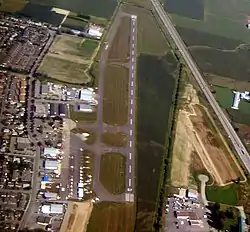
Chilliwack Airport is a small regional airport located in Downtown Chilliwack. It has 1,219 m (3,999 ft) of paved and lit runway that includes a parallel taxiway. Approximately 70% of the estimated 60,000 annual air traffic movements are itinerant traffic that consists of both pilot training and recreational flights from all around BC and south of the border.
Active transportation
There are 673 km (418 mi) of active transportation throughout the city, the most per capita of any municipality in the Lower Mainland.[44]
Highways
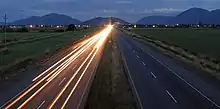
A four-lane to six-lane expressway from Horseshoe Bay to Hope runs through Chilliwack on the Lower Mainland section of the Trans-Canada Highway.
The Agassiz-Rosedale Highway is a north–south route in the eastern part of Chilliwack that acts as the last connection between Highways 1 and 7 eastbound before Hope, and is the main access to the resort village of Harrison Hot Springs. The highway first opened in 1953, originally going between Yale Road in Rosedale and Highway 7, with a ferry across the Fraser River. A bridge replaced the ferry in 1956. When the section of Highway 1 east of Chilliwack opened in 1961, Highway 9 was extended south to a junction with the new Highway 1 alignment, which replaced Yale Road as the main route between Chilliwack and Hope.
Mass transit

Chilliwack Transit System consists of a fleet of 9 buses that operate along regularly scheduled routes throughout the metropolitan area.
Passenger rail
British Columbia Electric Railway | ||||||||||||||||||||||||||||||||||||||||||||||||||||||||||||||||||||||||||||||||||||||||||||||||||||||||||||||||||||||||||||||||||||||||||||||||||||||||||
|---|---|---|---|---|---|---|---|---|---|---|---|---|---|---|---|---|---|---|---|---|---|---|---|---|---|---|---|---|---|---|---|---|---|---|---|---|---|---|---|---|---|---|---|---|---|---|---|---|---|---|---|---|---|---|---|---|---|---|---|---|---|---|---|---|---|---|---|---|---|---|---|---|---|---|---|---|---|---|---|---|---|---|---|---|---|---|---|---|---|---|---|---|---|---|---|---|---|---|---|---|---|---|---|---|---|---|---|---|---|---|---|---|---|---|---|---|---|---|---|---|---|---|---|---|---|---|---|---|---|---|---|---|---|---|---|---|---|---|---|---|---|---|---|---|---|---|---|---|---|---|---|---|---|---|
| ||||||||||||||||||||||||||||||||||||||||||||||||||||||||||||||||||||||||||||||||||||||||||||||||||||||||||||||||||||||||||||||||||||||||||||||||||||||||||
Chilliwack historically was served by the British Columbia Electric Railway New Westminster–Chilliwack interurban line. The company announced its "Rails-to-Rubber" conversion programme in 1944, and the Chilliwack line ceased service in 1950.[45]
In 2019, the South Fraser Community Rail Society was launched by former BC premier Bill Vander Zalm and former mayor of Langley Township Rick Green, to resurrect passenger service using the former BCER right-of-way. The proposed light-rail line would be 103 km (64 mi) long.[46][47]
Education
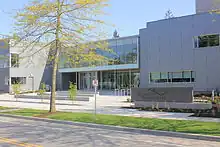
Post-secondary
Canada Education Park is an 86-acre (35 ha) campus in the Vedder Crossing neighbourhood on the south side of Chilliwack that houses several post-secondary institutions, including the University of the Fraser Valley, the RCMP Pacific Region Training Centre, and the Justice Institute of British Columbia.
The University of the Fraser Valley (UFV) is the largest post-secondary school in Chilliwack, and the seventh largest in British Columbia in terms of full-time enrolment. It offers master's degrees, bachelor's degrees, associate degrees, diplomas, certificates and citations across a range of programs in fine arts, humanities, science, social sciences, applied communication, business, nursing, as well as technical and trade programs. Its campuses are located in Abbotsford, Chilliwack, Hope and Mission.
Private
| School | Level | Grades |
|---|---|---|
| Saint Mary's | Elementary | K-7 |
| Unity Christian School | Elementary-Secondary | K-12 |
| John Calvin School | Elementary | K-7 |
| Timothy Christian School | Elementary-Secondary | K-12 |
| Highroad Academy | Elementary-Secondary | K-12 |
| Mount Cheam Christian School | Elementary-Secondary | K-12 |
| Chilliwack Adventist Christian School | Elementary-Junior secondary | K-7 |
| Cascade Christian School | Elementary-Junior secondary | K-12 |
Public
| School | Level | Grades |
|---|---|---|
| Bernard Elementary | Elementary | K-5 |
| Central Elementary Community School | Elementary | K-5 |
| Cheam Elementary | Elementary | K-5 |
| Cultus Lake Elementary | Elementary | K-5 |
| East Chilliwack Elementary | Elementary | K-5 |
| Evans Elementary | Elementary | K-5 |
| F.G. Leary Fine Arts Elementary | Elementary | K-5 |
| Greendale Community Elementary | Elementary | K-5 |
| Little Mountain Elementary | Elementary | K-5 |
| McCammon Traditional Elementary | Elementary | K-5 |
| Promontory Heights Elementary | Elementary | K-5 |
| Robertson Elementary | Elementary | K-5 |
| Rosedale Traditional Community | Elementary, Middle | K-8 |
| Sardis Elementary | Elementary | K-5 |
| Strathcona Elementary | Elementary | K-5 |
| Tyson Elementary | Elementary | K-5 |
| Unsworth Elementary | Elementary | K-5 |
| Vedder Elementary | Elementary | K-5 |
| Watson Elementary | Elementary | K-5 |
| Yarrow Community Elementary | Elementary | K-5 |
| A.D. Rundle Middle | Middle | 6-8 |
| Chilliwack Middle | Middle | 6-8 |
| Mt. Slesse Middle | Middle | 6-8 |
| Rosedale Traditional Community | Middle | 6-8 |
| Vedder Middle | Middle | 6-8 |
| Chilliwack Secondary | Secondary | 9-12 |
| G.W. Graham Secondary | Secondary | 9-12 |
| Imagine High Integrated Arts and Technology Secondary | Secondary | 9-12 |
| Sardis Secondary | Secondary | 9-12 |
| CHANCE Alternate | Alternative | SU |
| Education Centre | Alternative | 8-12 |
| Fraser Valley Distance Education | Alternative | K-12 |
| Shxwetetilthet: Sto:Lo | Alternative |
The Conseil scolaire francophone de la Colombie-Britannique operates one Francophone school: école La Vérendrye primary school.[49]
See also
Notes
- ↑ Statistic includes all persons that did not make up part of a visible minority or an indigenous identity.
- ↑ Statistic includes total responses of "Filipino" and "Southeast Asian" under visible minority section on census.
- ↑ Statistic includes total responses of "Chinese", "Korean", and "Japanese" under visible minority section on census.
- ↑ Statistic includes total responses of "West Asian" and "Arab" under visible minority section on census.
- ↑ Statistic includes total responses of "Visible minority, n.i.e." and "Multiple visible minorities" under visible minority section on census.
References
- ↑ "Fraser Valley Climbing Society". Retrieved 2021-01-11.
- ↑ "FVMBA". Retrieved 2021-01-11.
- ↑ "CCE Paddling Club". CCE Paddling Club. Retrieved 2021-01-11.
- ↑ "West Coast Soaring Club | The place for free flight pilots". Retrieved 2021-01-11.
- ↑ "Census Profile, 2021 Census Chilliwack [Census metropolitan area], British Columbia and British Columbia [Province]". 9 February 2022.
- ↑ "Chilliwack River". BC Geographical Names.
- ↑ Chilliwack Museum and Archives
- ↑ "History of Chilliwack". gov.chilliwack.bc.ca. City of Chilliwack. Retrieved 9 March 2014.
- ↑ Carlson, Keith Thor (2001). A Stó:lō-Coast Salish Historical Atlas. Vancouver, BC: Douglas & McIntyre. pp. 18–20. ISBN 1-55054-812-3.
- ↑ "Abbotsford, B.C., issues urgent appeal to evacuate Sumas Prairie citing possible catastrophic flooding". cbc.ca. November 16, 2021. Archived from the original on 2021-11-16. Retrieved November 17, 2021.
- 1 2 "Canada's Top 10 cities for weather - Macleans.ca". Macleans.ca. Retrieved 1 January 2019.
- ↑ "Agriculture". Chilliwackeconomicpartners.com. Archived from the original on 2 March 2014. Retrieved 9 March 2014.
- ↑ "Directors' Theatre Festival". Ufv.ca. Archived from the original on 2014-03-03. Retrieved 3 March 2014.
- ↑ "Chilliwack's new arts and tech school taking shape at old UFV site - Chilliwack Progress". www.theprogress.com. 2021-02-03. Retrieved 2022-11-30.
- ↑ "CSOPA Programs". Csopa.ca. Retrieved 1 January 2019.
- ↑ "VIDEO: Chilliwack morphing into city of street murals". 28 July 2021.
- ↑ "Latest downtown Chilliwack mural an homage to local waters". 21 July 2021.
- ↑ "Chilliwack's newest mural is a part of this year's festival offerings". 6 June 2021.
- 1 2 "CMEC Museum". cmedcentre.ca. Chilliwack Military Educations Center Museum. Archived from the original on 2014-05-17. Retrieved 9 March 2014.
- ↑ Chilliwack City Hall. Canadian Register of Historic Places. Retrieved 29 October 2011.
- ↑ "Chilliwack Museum and Archives". chilliwackmuseum.ca. Chilliwack Museum and Historical Society. Retrieved 9 March 2014.
- ↑ Lazaruk, Susan (2011-06-25). "'Moving, simple and beautiful' services held for Betty Fox, 73". Postmedia News. Windsor Star. Archived from the original on 2019-12-14. Retrieved 2011-06-27.
- ↑ "Chilliwack secondary grad from 1990 wins golden Grammy". Black Press. Chiliwack Progress. Retrieved 19 March 2017.
- ↑ Books, L. L. C. (1 May 2010). People from Chilliwack, British Columbi: Jim Vallance, W. P. Kinsella, Chuck Strahl, Dave Archibald, Keith Hunter Jesperson, Brett Sonne. General Books LLC. ISBN 9781155573991. Retrieved 1 January 2019 – via Google Books.
- ↑ "POST SCRIPT: Chilliwack Times publishes final edition - News". Archived from the original on 2017-06-06. Retrieved 2019-01-27.
- ↑ Goalline, Canada
- ↑ "Chilliwack, British Columbia Köppen Climate Classification (Weatherbase)". Weatherbase. Retrieved 2019-02-23.
- ↑ "Climatological Information for Besançon, France". Meteo France. 14 February 2019. Archived from the original on 12 June 2018. Retrieved 23 February 2019.
- ↑ "Orléans (45)" (PDF). Fiche Climatologique: Statistiques 1981–2010 et records (in French). Meteo France. Retrieved 14 February 2019.
- ↑ David Phillips (2010). "WeatherStats: Weather Winners". Environment Canada.
- ↑ "Historical Data - Climate - Environment and Climate Change Canada". 31 October 2011.
- 1 2 3 "Chilliwack A". Canadian Climate Normals 1981–2010. Environment Canada. Aug 23, 2021. Archived from the original on 2016-06-29. Retrieved Aug 23, 2021.
- ↑ "Chilliwack A". Canadian Climate Normals 1981–2010. Environment Canada. 25 September 2013.
- ↑ "Cultus Lake". Daily Data Report For Aug 2021. Environment Canada. 31 October 2011.
- ↑ "Cultus Lake". Daily Data Report For June 2021. Environment Canada. 31 October 2011.
- ↑ "Population and dwelling counts: Canada, provinces and territories, census metropolitan areas and census agglomerations". Statistics Canada. February 9, 2022. Retrieved March 28, 2022.
- ↑ "Population and dwelling counts: Canada, provinces and territories, and census subdivisions (municipalities), British Columbia". Statistics Canada. February 9, 2022. Retrieved February 20, 2022.
- 1 2 Government of Canada, Statistics Canada (2022-10-26). "Census Profile, 2021 Census of Population". www12.statcan.gc.ca. Retrieved 2022-11-09.
- ↑ Government of Canada, Statistics Canada (2021-10-27). "Census Profile, 2016 Census". www12.statcan.gc.ca. Retrieved 2022-11-26.
- ↑ Government of Canada, Statistics Canada (2015-11-27). "NHS Profile". www12.statcan.gc.ca. Retrieved 2022-11-26.
- ↑ Government of Canada, Statistics Canada (2019-08-20). "2006 Community Profiles". www12.statcan.gc.ca. Retrieved 2022-11-26.
- ↑ Government of Canada, Statistics Canada (2019-07-02). "2001 Community Profiles". www12.statcan.gc.ca. Retrieved 2022-11-26.
- ↑ "Local economy". Chilliwackeconomicpartners.com. Archived from the original on 2 March 2014. Retrieved 9 March 2014.
- ↑ "General Statistics - Schedule 201". Municipal general and financial statistics - Province of British Columbia. Ministry of Municipal Affairs. Retrieved 28 December 2023.
- ↑ Ewert, Henry (January–February 2010). "British Columbia Electric Railway Company Limited" (PDF). Canadian Rail (534): 3–9. Archived from the original (PDF) on 22 June 2013. Retrieved 26 November 2023.
- ↑ Gold, Kerry (July 12, 2019). "Push begins to rebuild Vancouver-Chilliwack rail line". The Globe and Mail. Archived from the original on July 12, 2019. Retrieved July 12, 2019.
- ↑ "South Fraser Community Rail". Retrieved 26 November 2023.
- ↑ "Reconfiguration | Chilliwack School District #33". www.sd33.bc.ca. Retrieved 2019-05-28.
- ↑ "Carte des écoles Archived 2015-08-17 at the Wayback Machine." Conseil scolaire francophone de la Colombie-Britanique. Retrieved on 22 January 2015.
External links
- Official website

 Chilliwack travel guide from Wikivoyage
Chilliwack travel guide from Wikivoyage